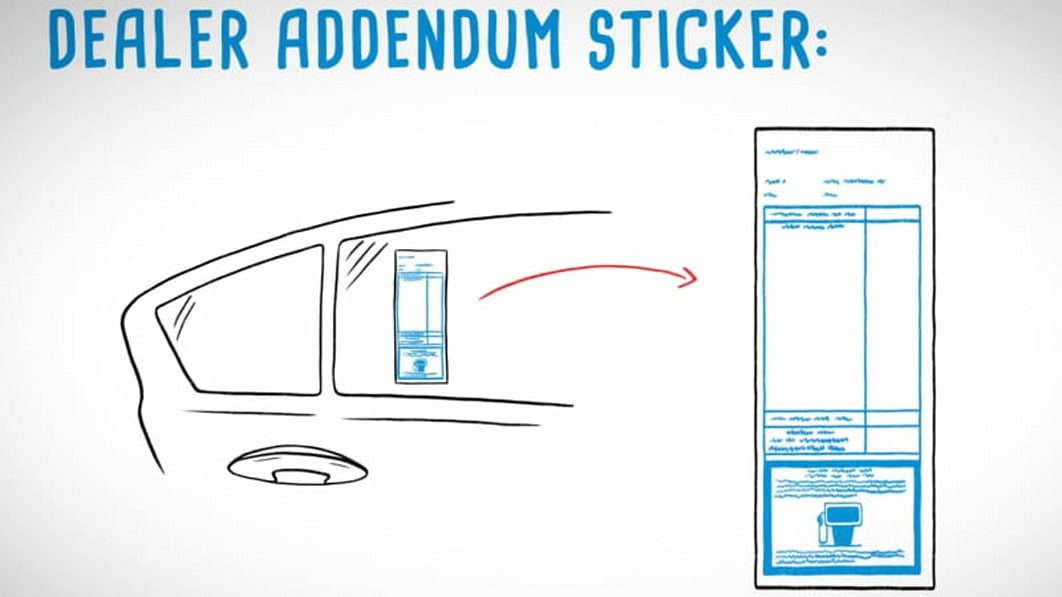What is a dealer addendum sticker on a car?

This is part of our Car Buyer’s Glossary series breaking down all the terms you need to know if you’re buying a new or used car from a dealership.
What’s the difference between MSRP and an addendum sticker?
Great question. From a car buyer’s perspective, neither of these things should be a factor in any of your negotiations. The Manufacturer’s Suggested Retail Price is technically what a manufacturer thinks a dealer should charge for a vehicle, but as you well know, in the real world cars sell for whatever a buyer can get a dealer to agree to. Whether it’s well below or well above MSRP is due to supply and demand, as well as the negotiation skills of the buyer.
With that in mind, the dealer addendum sticker is something the dealer adds, usually next to the Monroney sticker that lists the MSRP, destination charge, and other useful information. The addendum shows parts or services that the dealer has added to the vehicle before putting it up for sale. The parts could be running boards or floor mats, and the services could be applying a paint protectant or adding a security system. This is also where the dealer will list any mark-up.
What’s a dealer mark-up?
That’s an adjustment to the asking price made by the dealer that reflects either real-world demand for a very hot vehicle (or even mildly lukewarm vehicles in the Covid era), or a tactic to move the goalposts in the negotiation. There is nothing to prevent dealers from marking up cars, but manufacturers usually frown on it and can even take various steps to dissuade it.
What do you mean by moving the goalposts?
Well, regardless of what’s actually listed on the addendum sticker, there’s no law related to how much the dealer can charge for a particular line-item or mark-up. They could claim a set of running boards is worth $200,000 if they want to (accessories are often a key profit earner for dealers and sales people). The dealer mark-up could be reasonable or ludicrous. On some level, unless you blindly pay the total price listed on the addendum sticker, it doesn’t matter.
The psychological tactic here is that the higher the starting point in the negotiations, the more likely you’ll think the price you manage to negotiate down to is fair. If the dealer’s total mark-up is $5,000, and you talk them down $7,000, that seems like a victory. But if the vehicle’s actual value is $12,000 less than the dealer’s asking price, based on real-world transaction data in your location, you think you got a good deal but actually you just got taken for a ride.
So the dealer addendum is basically bogus?
Well, not really — but it depends. That sounds like a weaselly answer, but that’s only because dealer add-ons are a weaselly subject. Dealer-added physical accessories do have an intrinsic value — that value is whatever you and the dealer agree on. But some line items on an addendum sticker can be bogus. A fee for washing the car before delivery? The dealer shouldn’t pass that onto you — it’s part of doing business! That’s like the dealer charging you for the gas they spent driving to the dealership in the morning.
We can’t tell you what a particular addendum line item is worth, or if it’s bogus, so you’ll have to use common sense here. And remember to not get caught up haggling over the value of a dealer-added roof rack and ignoring the overall price picture. If you save $50 on the roof rack but get hosed for an extra $2,000 somewhere else in the deal, you’ve been snared by the exact psychological trick that the dealer is counting on.
We’re not saying that you can negotiate every vehicle, no matter how popular, to a price below what’s listed on the addendum sticker. Some very limited-production, high-demand cars might legitimately sell for the total of what’s on the addendum, including mark-up (or, again, cars sold during low supply situations). But your best bet is to do your homework and come up with a different reference point to base your negotiations on.
So what price should I offer the dealer?
That’s a whole ‘nother can of worms, but the quick answer is that you’ll want to compare dealer invoice pricing with real-world sales information. You can view and compare invoice pricing using Autoblog’s Compare Cars tool.
You’ll use those values to determine your “walk away” number — a price that you won’t exceed to buy the car. Now, you’ll want to take the extra equipment listed on the addendum into account, but you can almost certainly ignore the inflated prices listed next to them. Some research sites will list pricing for factory-installed options, but dealer-installed options are sort of the Wild West — anything goes. So take the totality of the circumstances into account, and then use your best judgement to set your budget.
And remember: the car dealer is a business that expects to make a profit, and that’s fair. But there’s no reason you have to pay more than what’s fair. Good luck shopping!







